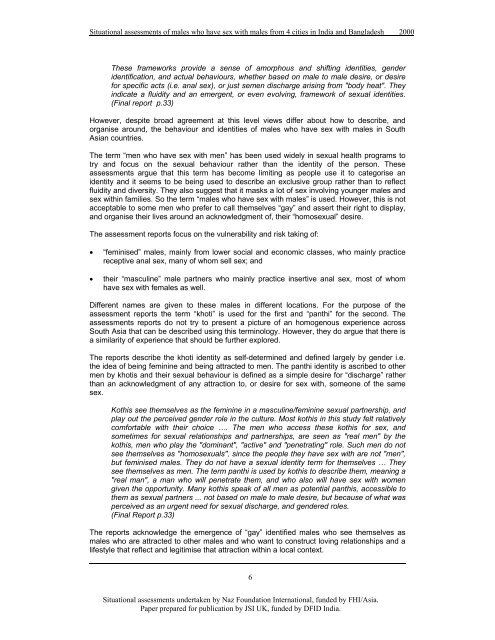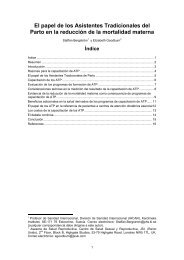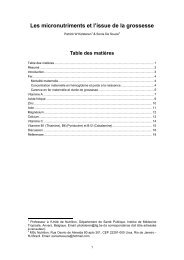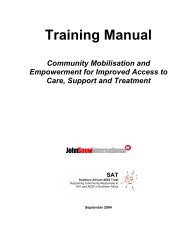Sexual Health of males in South Asia who have sex with other males
Sexual Health of males in South Asia who have sex with other males
Sexual Health of males in South Asia who have sex with other males
- No tags were found...
Create successful ePaper yourself
Turn your PDF publications into a flip-book with our unique Google optimized e-Paper software.
Situational assessments <strong>of</strong> <strong>males</strong> <strong>who</strong> <strong>have</strong> <strong>sex</strong> <strong>with</strong> <strong>males</strong> from 4 cities <strong>in</strong> India and Bangladesh 2000These frameworks provide a sense <strong>of</strong> amorphous and shift<strong>in</strong>g identities, genderidentification, and actual behaviours, whether based on male to male desire, or desirefor specific acts (i.e. anal <strong>sex</strong>), or just semen discharge aris<strong>in</strong>g from "body heat". They<strong>in</strong>dicate a fluidity and an emergent, or even evolv<strong>in</strong>g, framework <strong>of</strong> <strong>sex</strong>ual identities.(F<strong>in</strong>al report p.33)However, despite broad agreement at this level views differ about how to describe, andorganise around, the behaviour and identities <strong>of</strong> <strong>males</strong> <strong>who</strong> <strong>have</strong> <strong>sex</strong> <strong>with</strong> <strong>males</strong> <strong>in</strong> <strong>South</strong><strong>Asia</strong>n countries.The term “men <strong>who</strong> <strong>have</strong> <strong>sex</strong> <strong>with</strong> men” has been used widely <strong>in</strong> <strong>sex</strong>ual health programs totry and focus on the <strong>sex</strong>ual behaviour rather than the identity <strong>of</strong> the person. Theseassessments argue that this term has become limit<strong>in</strong>g as people use it to categorise anidentity and it seems to be be<strong>in</strong>g used to describe an exclusive group rather than to reflectfluidity and diversity. They also suggest that it masks a lot <strong>of</strong> <strong>sex</strong> <strong>in</strong>volv<strong>in</strong>g younger <strong>males</strong> and<strong>sex</strong> <strong>with</strong><strong>in</strong> families. So the term “<strong>males</strong> <strong>who</strong> <strong>have</strong> <strong>sex</strong> <strong>with</strong> <strong>males</strong>” is used. However, this is notacceptable to some men <strong>who</strong> prefer to call themselves “gay” and assert their right to display,and organise their lives around an acknowledgment <strong>of</strong>, their “homo<strong>sex</strong>ual” desire.The assessment reports focus on the vulnerability and risk tak<strong>in</strong>g <strong>of</strong>:• “fem<strong>in</strong>ised” <strong>males</strong>, ma<strong>in</strong>ly from lower social and economic classes, <strong>who</strong> ma<strong>in</strong>ly practicereceptive anal <strong>sex</strong>, many <strong>of</strong> <strong>who</strong>m sell <strong>sex</strong>; and• their “mascul<strong>in</strong>e” male partners <strong>who</strong> ma<strong>in</strong>ly practice <strong>in</strong>sertive anal <strong>sex</strong>, most <strong>of</strong> <strong>who</strong>m<strong>have</strong> <strong>sex</strong> <strong>with</strong> fe<strong>males</strong> as well.Different names are given to these <strong>males</strong> <strong>in</strong> different locations. For the purpose <strong>of</strong> theassessment reports the term “khoti” is used for the first and “panthi” for the second. Theassessments reports do not try to present a picture <strong>of</strong> an homogenous experience across<strong>South</strong> <strong>Asia</strong> that can be described us<strong>in</strong>g this term<strong>in</strong>ology. However, they do argue that there isa similarity <strong>of</strong> experience that should be further explored.The reports describe the khoti identity as self-determ<strong>in</strong>ed and def<strong>in</strong>ed largely by gender i.e.the idea <strong>of</strong> be<strong>in</strong>g fem<strong>in</strong><strong>in</strong>e and be<strong>in</strong>g attracted to men. The panthi identity is ascribed to <strong>other</strong>men by khotis and their <strong>sex</strong>ual behaviour is def<strong>in</strong>ed as a simple desire for “discharge” ratherthan an acknowledgment <strong>of</strong> any attraction to, or desire for <strong>sex</strong> <strong>with</strong>, someone <strong>of</strong> the same<strong>sex</strong>.Kothis see themselves as the fem<strong>in</strong><strong>in</strong>e <strong>in</strong> a mascul<strong>in</strong>e/fem<strong>in</strong><strong>in</strong>e <strong>sex</strong>ual partnership, andplay out the perceived gender role <strong>in</strong> the culture. Most kothis <strong>in</strong> this study felt relativelycomfortable <strong>with</strong> their choice …. The men <strong>who</strong> access these kothis for <strong>sex</strong>, andsometimes for <strong>sex</strong>ual relationships and partnerships, are seen as "real men" by thekothis, men <strong>who</strong> play the "dom<strong>in</strong>ant", "active" and "penetrat<strong>in</strong>g" role. Such men do notsee themselves as "homo<strong>sex</strong>uals", s<strong>in</strong>ce the people they <strong>have</strong> <strong>sex</strong> <strong>with</strong> are not "men",but fem<strong>in</strong>ised <strong>males</strong>. They do not <strong>have</strong> a <strong>sex</strong>ual identity term for themselves … Theysee themselves as men. The term panthi is used by kothis to describe them, mean<strong>in</strong>g a"real man", a man <strong>who</strong> will penetrate them, and <strong>who</strong> also will <strong>have</strong> <strong>sex</strong> <strong>with</strong> womengiven the opportunity. Many kothis speak <strong>of</strong> all men as potential panthis, accessible tothem as <strong>sex</strong>ual partners ... not based on male to male desire, but because <strong>of</strong> what wasperceived as an urgent need for <strong>sex</strong>ual discharge, and gendered roles.(F<strong>in</strong>al Report p.33)The reports acknowledge the emergence <strong>of</strong> “gay” identified <strong>males</strong> <strong>who</strong> see themselves as<strong>males</strong> <strong>who</strong> are attracted to <strong>other</strong> <strong>males</strong> and <strong>who</strong> want to construct lov<strong>in</strong>g relationships and alifestyle that reflect and legitimise that attraction <strong>with</strong><strong>in</strong> a local context.6Situational assessments undertaken by Naz Foundation International, funded by FHI/<strong>Asia</strong>.Paper prepared for publication by JSI UK, funded by DFID India.






